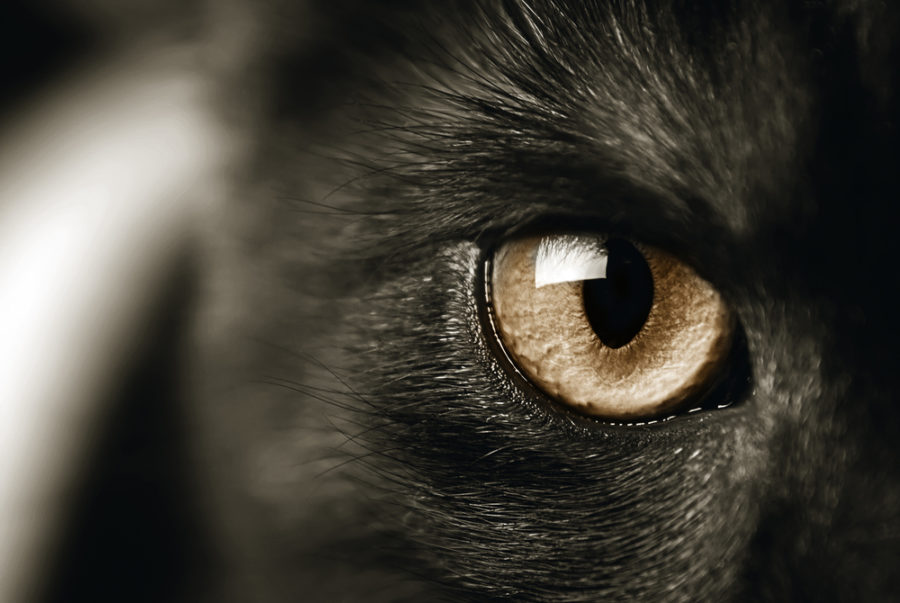Few things are more beautiful than the bright eyes of a happy healthy cat. Aside from being gorgeous, your feline’s peepers can tell you quite a lot about her well being.
It’s said that the eyes are the window to the soul. In cats (and other animals) they can also be the window to underlying health. Are your cat’s eyes bright and clear, or is there redness or chronic discharge? What does it mean if your cat’s third eyelids are visible? Is a change in eye color or pupil size reason for concern?
The conjunctivitis connection
Numerous infectious diseases cause eye problems in cats. Most are due to upper respiratory viruses like rhinotracheitis (a herpesvirus), calicivirus and chlamydia. All three cause, among other things, conjunctivitis (swelling of the conjunctive tissues). Kittens, older cats and those living in multi-cat environments are more susceptible. Because rhinotracheitis is a herpesvirus, a cat that had it as a kitten may have recurrent flare-ups when stressed.
If the conjunctivitis is mild, it can be treated at home. Often, though, the eye(s)will become stuck shut and that can result in corneal ulcers. Oral antibiotics are usually not effective because all three of these upper respiratory problems are viruses. If your kitten or cat is suffering from conjunctivitis, it is important to keep the eye moist and lubricated. An antibiotic ointment
will do this, but I have always used artificial tears lubricant whenever I had kittens with conjunctivitis.
There are vaccinations against rhinotracheitis, calicivirus and chlamydia. The first two are core vaccines and should be received by all kittens, but the chlamydia vaccine is usually not recommended due to potential
side effects. As is the case with all vaccinations, they do not offer total protection and may cause subsequent chronic disease.
Corneal ulcers, should they occur, are serious and should be treated by a veterinarian. I have had great success in treating corneal ulcers using both homeopathy and the application of liquid, food-grade vitamin E and vitamins A/D in the eye several times a day. Vitamin E in particular helps heal scarring.
Many veterinarians will recommend supplementation with the amino acid lysine to help with herpesvirus flare-ups. I have had more success supplementing my cats’ diet with taurine, an essential amino acid for felines. A diet insufficient in taurine results in central retinal degeneration (eye lesions) which can lead to blindness. Taurine can also protect against cataracts and diseases of the retina.
More red flags
Glaucoma
Glaucoma can be difficult to diagnose in cats because their eyes are able to withstand much greater pressure elevation without visible evidence of disease. Signs to watch for: Increased size in the cat’s eye and/or pupil, a cloudy appearance.
Cataracts
Cataracts are relatively rare in cats and usually related to complications from diabetes or uveitis. Some purebred breeds are more susceptible than others. With cataracts, it pays to catch the problem early. Long-term cataracts are harder to remove. Signs to watch for: A distinct disparity in eye clarity, increased opacity, cloudiness or a change in pupil size.
Uveitis
The uvea consists of three parts: the iris, the ciliary body (the tissue immediately behind the iris) and the choroids (the vascular layer in the back of the eye that supplies nutrition to the retina). Uveitis may occur spontaneously or secondary to diseases such as feline leukemia, FIV or FIP. Signs to watch for: A change in iris color may indicate uveitis or iris melanomas. With both of these, cats most commonly develop a brown color change that affects much of the iris.
All of the above conditions are serious and may lead to blindness or eye removal. If you notice any changes in your cat’s eyes, she should be seen by a veterinarian. Take the time to stare into your cat’s eyes on a daily basis. Not only will you enjoy the visual interaction, but it also gives you a chance to notice if there’s anything amiss with those beautiful orbs.
Did you know?
• The cat evolved as a nocturnal predator, so her pupils can get much larger than ours can. This lets in more light, but at the expense of good depth of field.
• When a cat’s pupil contracts, it doesn’t stay round like a person’s, but instead becomes a vertical slit. Why? Slit pupils can change size much faster than round pupils can. The disadvantage is that they create optical interference that makes perfect focus difficult.
• A cat’s lens is much larger than the human lens. This enables it to gather more light, but there’s a tradeoff. A smaller lens can change shape to focus light over a great range of distances. Because a cat’s lens can hardly change shape at all, felines have difficulty focusing on objects very close to them.
• Cats have large eyes and retinas for their size. The retina contains two important kinds of cell:
1. Rods – which respond to very low levels of light and do not distinguish between colors.
2. Cones – which need a higher light level, but can respond to many different colors.
A cat’s retina is rod-rich with very few cones. In fact, the level of retina illumination is about five times higher in your cat’s eye than in yours. The tapetum lucidum in the back of a cat’s eye reflects light back to the receptors in the retina to give it a second chance to receive a signal. That’s why cats’ eyes reflect light in the dark.
• The feline brain is hardwired to detect and react to motion. Because cats evolved as carnivores, their eyes are in front of their heads – unlike prey animals which tend to have them on the sides of their heads. When your cat is getting ready to pounce on a toy, you may see her moving her head rapidly from side to side. She is doing this to better judge the distance between herself and her “prey.”







